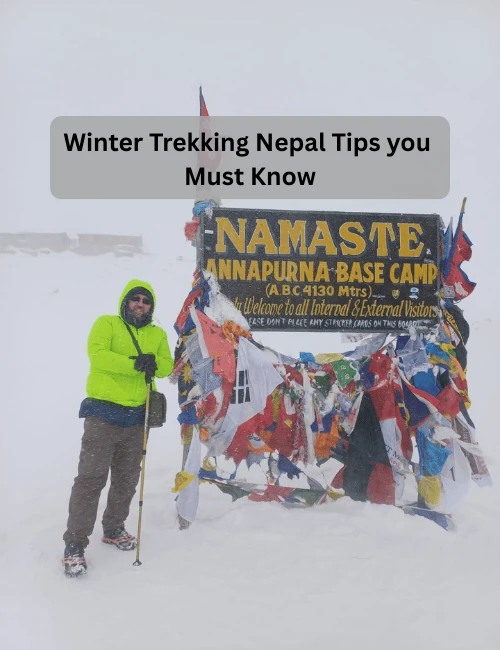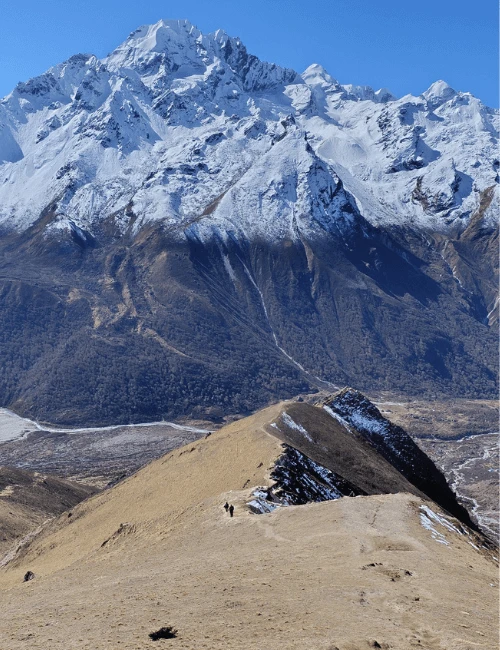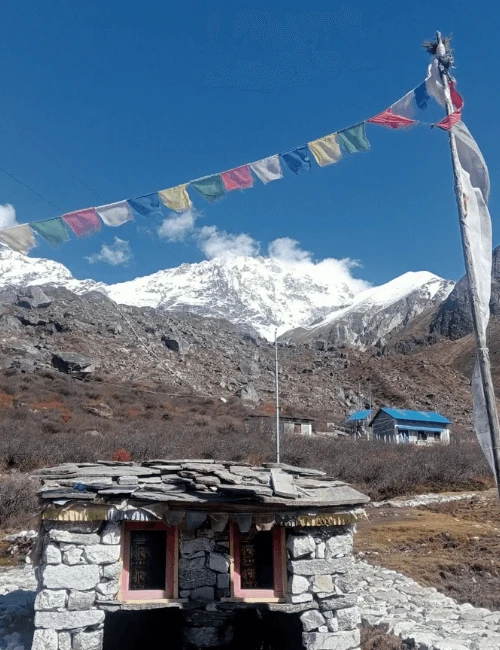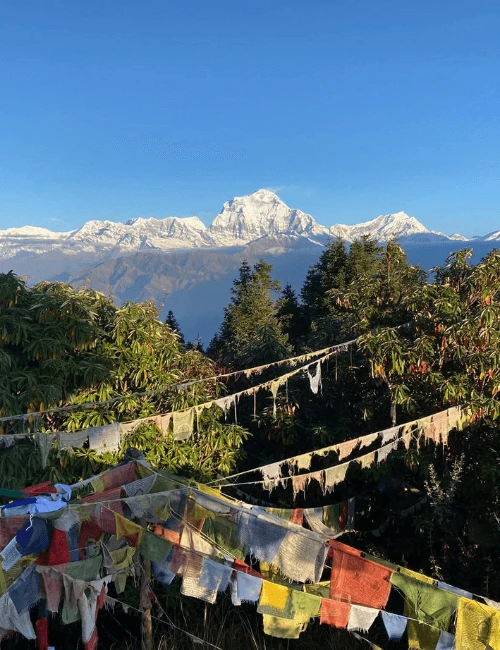Those adventure climbers who are wondering about Lobuche East Peak difficulty, this 6,119m climb in Nepal's Everest region presents a challenging yet rewarding experience. Lobuche East is rated PD+ on the Alpine difficulty scale. It means the climb is a moderately difficult ascent with some technical sections, such as steep snow slopes and the use of fixed ropes. Although Lobuche Peak is classified as a trekking peak, the difficulty level should not be underestimated. high altitude, unpredictable weather, and the strenuous trek to high camp all test a climber’s endurance. In this blog, we break down what makes Lobuche East climbing challenging compared to other peaks, the fitness and training required, the best seasons to attempt it, and whether this peak is suitable for beginner mountaineers. We’ll also highlight safety challenges and answer frequently asked questions to help you prepare for a successful Lobuche Peak climb. Let’s dive in!
Lobuche East Peak Difficulty, How Hard Is This 6119m Climb?
Lobuche Peak Difficulty Level: You must know
Lobuche Peak Climbing is one of the best trekking peaks in Nepal, suitable for beginners. Having said that, do not underestimate the Lobuche East Peak Difficulty if you are trying to climb it for the first time. Standing at 6,119 meters (20,075 ft) near Mount Everest, Lobuche East demands dedication and some mountaineering skill despite being a non-expedition peak.
It is officially graded PD+ (Peu Difficile Plus) on the alpine climbing scale – meaning “moderately difficult.” In practical terms, the PD+ grade reflects that climbing Lobuche East requires using mountaineering gear (crampons, ice axe, harness, fixed ropes) on steep snow and ice terrain. So, how hard is Lobuche East in reality, and how does it compare to other peaks in its class? Below, we’ll explore Lobuche East’s difficulty level in detail – from what makes it challenging, to the training and preparation you need, the best time to climb, and safety considerations on the mountain.
What makes Lobuche East Peak difficult compared to other trekking peaks?
Lobuche East’s difficulty level stands out among Nepal’s trekking peaks due to its combination of technical terrain, altitude, and summit day length. While trekking peaks like Mera Peak (6,476m) or Island Peak (6,189m) are also challenging, Lobuche East is considered a notch tougher. Here are the key factors that set Lobuche East apart:
Higher Technical Grade
Lobuche East is rated PD+, whereas Mera Peak is PD (one step easier). The “+” indicates additional technical challenges – in fact, Lobuche East shares the same PD+ grade as Island Peak, but many climbers feel Lobuche is a bit more demanding in practice. This is because Lobuche has more technical sections involving mixed rock and ice climbing, steeper slopes, and fixed ropes, especially near the summit. By comparison, Mera Peak Climbing is a straightforward glacier walk with gentler slopes and minimal rope work.
Steep Final Ascent
The crux of Lobuche East is a very steep summit slope (~45–50°) and an exposed summit ridge. Climbers must ascend a 50-meter vertical-ish snow/ice wall just below the summit and balance along a narrow ridge, usually protected by fixed lines. This requires strength, good crampon technique, and comfort with exposure. Many other trekking peaks have gentler final slopes – for example, Mera Peak’s final section is much more gradual. The steepness of Lobuche’s summit push undeniably makes it feel harder than a “basic” trekking peak.
Glacier and Mixed Terrain
The climb involves navigating a glacier and sections of rock. From high camp, you traverse a glacier with potential crevasses (requiring rope team travel and careful footwork), then tackle mixed rock and snow on the ridge. Lobuche East’s technical sections include everything from rocky scrambling out of High Camp to front-pointing on snow/ice higher up. In contrast, some easier peaks might be solely snow climbs or hiking on trails. The varied terrain on Lobuche demands a broader skill set.
Altitude and Endurance
Like all 6000m peaks, high altitude is a big part of the challenge. Lobuche East may be slightly lower than Mera or Island Peak, but it still rises above 6,100m, where the air is very thin. The climb often follows an Everest Base Camp trek for acclimatization, yet the altitude will tax your lungs and legs. Summit day on Lobuche involves 1,000+ meters of elevation gain (from ~5,300m at High Camp to 6,119m) and can take 10–12 hours round trip. That is a very long, strenuous day by any standard, made even harder by low oxygen levels. Many climbers find Lobuche’s summit push more exhausting than Island Peak’s, even though Island is taller, because of the sustained steep climbing.
In summary, Lobuche East Peak’s difficulty comes from being a “moderate+” climb that borders between a trekking peak and a full alpine climb. It’s not an extreme expedition, but it is harder than the easiest 6000m peaks. As one source puts it: Mera Peak is PD (“moderate”), while Lobuche East is PD+ (“moderate-plus”) – neither is extreme, but the plus means extra challenge. For climbers with some experience, PD+ is very manageable with the right preparation. But for first-timers, that step up can be noticeable. This is why Lobuche East is often attempted by those who may have already done a peak like Mera Peak climbing or at least taken basic mountaineering training. Next, we’ll look at the route details and other factors that contribute to Lobuche East’s reputation.
Trek route from Lobuche Base Camp to High Camp
The journey to Lobuche East’s summit begins long before you don crampons. Trekkers typically reach Lobuche East Base Camp (4950m) after acclimatizing with a trek, often the Everest Base Camp trek. From Base Camp, the real climb starts as you move to High Camp and beyond. The section from Lobuche Base Camp to High Camp is relatively short in distance but quite demanding. The trail from Base Camp to High Camp gains roughly 400–500 vertical meters, up to an altitude of about 5,400m. Though it may only take 3–4 hours, it’s a tough half-day. The route is rocky with lots of boulders, and you’ll often need to use your hands for balance (light scrambling) as you ascend. In some sections, fixed ropes may be set up to assist with climbing over the steeper rocks. Walking in this terrain is never easy – expect a slow, steady slog.
Overall, the trek from Lobuche Base Camp to High Camp is a challenging hike/climb that prepares you for the summit push. It may only be a few hours of movement, but at that altitude, with a heavy pack and tricky terrain, it requires immense physical fitness and sure-footedness to do it safely. Climbers often arrive at High Camp feeling the effort, which is why good acclimatization and fitness are essential.
Physical fitness required to combat Lobuche East Peak Difficulties
There is no doubt: you must be in excellent physical shape to successfully climb Lobuche East. This peak might be classified as a “trekking” climb, but it pushes your endurance to the limit. You’ll be trekking for many days just to reach Base Camp, and then tackling extremely demanding ascents at high altitude. Here are some key fitness considerations:
- Endurance for Long Days: Summit day on Lobuche East can be 10–12+ hours of continuous effort. Climbers often start around 2 AM and might not return to camp until late morning or midday. This requires tremendous stamina. You should be comfortable hiking 6–8 hours day after day during the approach, and then have the reserve to push through a very long summit climb. Fatigue will compound at altitude, so the better your endurance, the more you can cope with the lengthy exertion.
- High Altitude Strain: At over 6,000m, each step can feel like three. Even very fit people will be out of breath quickly above, say, 5,500m. Being in great shape doesn’t make you immune to altitude effects, but it does help your body use oxygen more efficiently. Good cardiovascular fitness means you’ll recover faster when taking breaks. If you arrive in poor shape, the thin air and physical work may exhaust you to the point where you can’t continue. Many who underestimate Lobuche East’s physical demand struggle on summit day due to sheer exhaustion.
- Strength for Steep Climbing: Unlike a normal trek, climbing Lobuche East involves pulling yourself up ropes and steep snow. Having strong legs is crucial for the endless uphill steps with a heavy boot and crampons on. You’ll also benefit from a solid core and upper-body strength – for example, ascending fixed ropes with a jumar device is much easier if you have some arm and core strength to stabilize yourself. A climber with good overall strength and conditioning will handle the technical sections more efficiently.
- Mental and Physical Resilience: “Physical fitness” isn’t just muscles and lungs – it’s also about mental toughness, which often comes from training hard. Climbing Lobuche East will test you with cold pre-dawn starts, discomfort, and moments of doubt when the ascent feels unending. Preparing your body through rigorous training inherently prepares your mind as well.
In short, climbing Lobuche East Peak requires a high level of fitness. Aim to be in the best shape of your life for this expedition. This will not only increase your chance of summiting but also make the entire experience more enjoyable (or, less suffering!). Next, we’ll outline how to train and prepare for Lobuche East specifically.
How to train for climbing Lobuche East Peak
Proper Lobuche Peak climbing preparation can make the difference between a successful, enjoyable climb and a difficult, painful one. Given the peak’s demands, you should start training months in advance. Here’s how to prepare:
- Build Aerobic Endurance: Focus on cardiovascular training that improves your stamina. Activities like running, cycling, swimming, and uphill hiking are great.
- Increase Leg and Core Strength: Strength training will prepare your muscles for the strain of climbing and carrying gear. Emphasize your quads, glutes, calves, and core. Exercises like squats, lunges, step-ups, deadlifts, and stair climbing will build the leg power needed for steep uphill sections.
- Train with Altitude or Simulation: The best “training” for altitude is actually to include a trekking approach (like the Everest Base Camp trek) as part of your trip, which most Lobuche East itineraries do.
- Learn Mountaineering Skills: Technical training is a must because Lobuche East involves mountaineering techniques. Before the trip, try to attend a basic mountaineering course or a guided alpine skills weekend.
- Pack Training & Hiking: Remember that you’ll also be trekking with a pack for days. Get used to hiking with a weighted backpack (maybe 10-15kg) on trails or uphill terrain.
- Mental Preparation: Maintain a positive mindset and visualize success. Big climbs can be as much a mental battle as a physical one. Training hard will give you confidence, but also be prepared for setbacks like bad weather or fatigue.
In general, try to start training 4–6 months before your Lobuche East climb. As summit time nears, ramp up the intensity, then taper off to rest during the final week before you fly to Nepal. By the time you arrive in the Khumbu, you want to be in top shape but well-rested. With solid preparation, you’ll find that the Lobuche Peak climb is still hard, but absolutely achievable – and you’ll enjoy the expedition a lot more when you’re not completely out of breath the whole time!
The best season to climb to avoid the Lobuche East Peak difficulty
Choosing the right season is crucial for stacking the odds in your favor. In Nepal, Lobuche East Peak can technically be climbed in any season, but conditions vary dramatically. The difficulty of the climb will be significantly affected by weather and trail conditions, so consider the following:
Climb Lobuche in Autumn (September–November)
This is widely regarded as the best season for Lobuche East. Post-monsoon autumn delivers stable weather, clear skies, and moderate temperatures – all of which make the climb easier. In autumn, the weather is excellent with crisp air, sunny days, and perfect visibility of the mountains. The consistently good weather means it is a better chance to do the summit successfully. Many climbers are scheduled for October, the peak of autumn, to maximize success odds. Overall, in terms of difficulty, autumn presents fewer weather-related challenges, letting you focus on the climb itself.
Lobuche Peak Climb in Spring (March–May)
Spring is the second most popular season and also an excellent time to climb. As the winter chill fades, March and April bring stable conditions similar to autumn. Early spring can be cold, but by April/May, the temperatures warm up and the snow from winter starts melting. The skies are generally clear, especially in April, though by May, there’s a bit more humidity and chance of afternoon clouds. One advantage of spring is longer daylight hours, which is helpful on a long summit day. Difficulty-wise, spring climbing is on par with autumn – both are considered the “normal” conditions for Lobuche East.
Is Lobuche East Peak Difficult for beginner mountaineers?
Lobuche East is often summited by beginner mountaineers, but it is on the more challenging end of beginner-friendly peaks. In other words, it’s doable for newcomers – especially those who are strong trekkers – but it’s not the easiest option out there. Here’s a nuanced look at whether a novice should consider Lobuche East:
Experience Recommended: While prior experience is not necessary, it is highly recommended. The climb involves technical elements and harsh conditions that can be overwhelming for someone’s very first climb. In fact, one analysis of recent expeditions showed that 100% of successful Lobuche East summiteers had previous 6,000m+ or technical climbing experience, and zero successful summiters were true first-time climbers in that data set. This statistic underscores that having some background – even just a basic mountaineering course or a smaller peak like Island Peak or Mera Peak under your belt – greatly improves your chances on Lobuche East.
Guided Training for Novices: That said, many fit beginners have reached the summit of Lobuche East, typically under the guidance of experienced expedition leaders. The Mountain Eco Trails team includes a training day at Lobuche Base Camp or High Camp, where we teach you how to use the gear (jumar, figure-8 descender, crampons, etc.) in a safe environment before the real climb.
Compared to Other “First” Peaks: Many consider Mera Peak or even Island Peak as slightly better first Himalayan climbs. Mera is higher but technically easier (no steep ridge or wall), and Island Peak, while it has a steep section, is often said to be a bit more straightforward than Lobuche’s mixed climb. Lobuche East’s PD+ grade and its “more technical feel” mean it’s a step up in difficulty from those.
Safety and Confidence: For beginners, safety is a major concern since you won’t have personal mountain judgment to rely on. Going with a reputable guide service is essential. The guides will fix ropes, manage crevasse crossings, set a safe pace, and handle altitude issues – all critical on a tougher peak like Lobuche.
Lobuche East can be suitable for beginners only if they are well-prepared and ideally not entirely new to high-altitude trekking. If you’ve done treks like Everest Base Camp or summited Kilimanjaro (for instance), you’re in a much better position to tackle Lobuche as your first technical climb. If you’re brand new to mountains, consider whether you can do some training climbs first. But if your heart is set on Lobuche East as a beginner, don’t be discouraged – just prepare thoroughly, go with experienced guides, and be ready to learn. Many climbers have taken their first crampon steps on Lobuche East’s slopes and succeeded, emerging as more seasoned mountaineers by the end of it.
Safety Challenges on the Lobuche East Peak Difficulty
Climbing in the Himalayas inherently comes with risks, and Lobuche East Peak is no exception. Understanding the safety challenges beforehand will help you mitigate them and climb more confidently. Here are the main safety considerations on Lobuche East:
Altitude and AMS: At 6,119m, Lobuche East lies in the altitude zone where acute mountain sickness (AMS) and even more severe forms like HACE/HAPE can occur. Climbers regularly experience mild symptoms like headaches, poor sleep, or appetite loss at high camp. Proper acclimatization is critical: that means spending enough days trekking (with rest days) before the climb and not rushing uphill. Altitude can also slow your reaction times and weaken you, so be aware that everything is harder up high – move at a sustainable pace and communicate with your team about how you feel.
Crevasse and Fall Hazard: The route after High Camp traverses the Lobuche glacier and then ascends steep snow/ice. This means crevasse danger is present – hidden cracks in the glacier that you could fall into if unroped or inattentive. Climbers mitigate this by roping up in teams during glacier travel, probing the route, and following the guidance of sherpas who know the typical crevasse patterns. Additionally, the steep summit ridge requires fixed ropes because a slip there could result in a very dangerous fall down the side of the mountain. It’s imperative to always clip into the fixed line with your harness and ascender and use proper climbing techniques. Unclip only when your guide tells you it’s safe. In short, one major safety challenge is preventing falls into crevasses, off ridges, or down steep slopes. This is managed by using ropes and traveling cautiously.
Rockfall and Icefall: In certain sections, particularly below high camp on the rocky parts or even on the mixed sections, there is a risk of rockfall (or ice chunks) coming down. This can be triggered by other climbers above or natural melting during the day. Always wear your helmet when climbing, even when trekking up to high camp through boulders.
Weather and Cold Injuries: Weather in the Himalaya can change rapidly. A clear morning can turn into an afternoon white-out or storm. High winds are especially dangerous on Lobuche’s exposed ridge – they can knock you off balance or cause frostbite by drastically lowering the wind chill. Listening to your guide is paramount; they might turn the team around before the summit if the weather deteriorates or if it’s getting too late in the day, because descending in darkness or storm is dangerously unsafe. Remember, the mountain will always be there for another try.
Limited Rescue Access: One often overlooked challenge is that once you are up on Lobuche East (especially above Base Camp), you are in a remote, high-altitude environment where rescue is difficult. Helicopters can sometimes evacuate climbers from Base Camp (around 5,000m) or even High Camp (5,400m) if weather allows, but above that, it’s nearly impossible to get a chopper in.
By being aware of these safety challenges on Lobuche East, you can take proactive steps to mitigate them. Choose a reputable guide service that prioritizes safety, ensure you have proper gear (and know how to use it), follow acclimatization protocols, and maintain a mindset that getting to the summit is optional but getting back down safely is mandatory. With good preparation and caution, Lobuche East can be climbed relatively safely, but it demands respect. As the saying goes, “There are old climbers and bold climbers, but no old bold climbers” – the mountain rewards those who climb smart.
FAQs
How difficult is Lobuche East Peak to climb?
Lobuche East is considered a moderately difficult climb by Himalayan standards. It’s more challenging than a simple trek but a notch below a major expedition. In the Alpine grading system, it’s rated PD+, which means it involves some technical climbing and is somewhat challenging.
What is the grade of Lobuche East Peak, and what does PD+ mean?
The grade of Lobuche East Peak is PD+ on the French Alpine Grade scale. “PD” stands for Peu Difficile, which translates to “a little difficult.” The plus “+” indicates it’s on the harder side of PD – so, essentially “a little difficult plus a bit more.” In practical terms, PD+ is still considered a moderate climb (not extreme), but it entails more technical effort than a plain PD route.
Are there technical sections on the Lobuche East climb?
Yes, Lobuche East has notable technical sections despite being called a trekking peak. The most prominent is the final 50-meter headwall of snow/ice just below the summit, which is roughly 45–50° steep. Climbers ascend this using fixed ropes (jumar on the way up, rappelling or arm-wrapping on the way down)
Do I need prior climbing experience to climb Lobuche East?
Prior experience is strongly recommended for Lobuche East, though not absolutely required in all cases. Many climbers tackle Lobuche East as their first Himalayan climb, but typically, they are people who have done high-altitude treks or smaller peaks before. A fit beginner under the supervision of experienced guides can succeed – just approach it with respect and willingness to learn.
How should I prepare for Lobuche Peak climbing?
Preparation for Lobuche East should begin months before your trip. Focus on trekking to high altitude with a back pack, strength training, mental preparation, and consult with the trekking agency like Mountain Eco Trails for the gear and the best time to climb the Lobuche Peak.
Conclusion on Lobuche East Peak Difficulty
Lobuche East Peak may be a “trekking peak” in name, but as we’ve seen, its difficulty is very real. From the steep ice slopes and technical sections to the thin-air endurance test of summit day, Lobuche East pushes you to dig deep both physically and mentally.
If you’re excited to take on the challenge of Lobuche East, make sure you’re well prepared – and consider doing it with an experienced team. Mountain Eco Trails specializes in guided climbs of Lobuche East and other Himalayan peaks. We provide expert Sherpa guides, a carefully planned itinerary with proper acclimatization, and training sessions to ensure you have the skills and confidence needed for the climb. Safety is our top priority, and we aim to turn a tough climb into a rewarding and life-changing experience for you. Contact us today via email or WhatsApp us at +9779849790153






